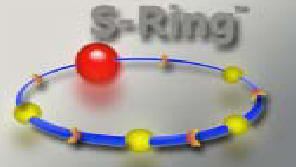
GarrettCom
S-Ring™ for Magnum 6K Switches
Software for Redundancy
Management

Call us for Pre-sales and discount pricing
on
Garrett S-Ring™ for Magnum 6K Switches
Software for Redundancy Management
301-924-7400
Support
S-Ring™ for
Magnum 6K Switches
Software for Redundancy
Management
Features
• Fast fault recovery in Industrial Ethernet LANs using a ring structure
• Operates with extensions to industry-standard Spanning Tree
• Multi-vendor switches and hubs supported in the rings
• Supports large rings over long distances using fiber media
• User controlled set-up for ring management via software commands
Description
Magnum™ S-Ring (patent pending) Redundancy Manager software
product, built upon networking industry standards including IEEE
802.1d Spanning Tree Protocol (STP), enables Magnum 6K Managed Switches to
simplify and speed up recovery from faults in Industrial Ethernet LAN
configurations that use a ring structure. With S-Ring, fault tolerant LANs
finally can have both standards and speed.
The S-Ring product supports multi-vendor Ethernet switches and hubs in the
rings. While fault recovery times will vary with the particular ring topology
and ring member devices selected, almost any ring using standard Ethernet
products will experience recovery
speed improvements over STP using S-Ring. In addition, S-Ring makes Ethernet
ring-topology LANs more reliable because fault
recovery is less complex and much faster. Industrial LANs often extend
over great distances using fiber media, and a ring structure provides fault
tolerance at low cost because it minimizes cabling expenses. The number of ring
members or “drops” may be 10 or 20, even 50 or more in some cases such as in
energy and transportation systems. Pipelines, railroads, windmill farms, oil and
gas producing fields, waterways and canals, tunnels, highways and city traffic
control systems are all good examples of redundant ring applications covering
large areas and long distances.
Other industrial facilities that benefit from large rings include water
treatment plants, mines and quarries, forest product mills, agricultural
buildings, and warehouses. With S-Ring, fault recovery speed is as fast for
large rings as it is for small rings.
S-Ring software operates in a Magnum 6K Switch from specifically defined port
pairs that have ring-topology Ethernet devices attached. It builds upon the
foundation of STP, but offers an additional option related specifically to ring
topologies. S-Ring acts to
recover the ring traffic from faults at sub-second speed, over-riding the STP
analysis delay but without conflicting with standard STP. The user configures
and controls the S-Ring set-up as part of the 6K Switch’s managed networks
software, MNS-6K. A Ring-Scan feature simplifies ring definitions and makes
reliable installation easy.
Specifications
| Ring-Closed: The two ring-control ports, interconnected by the ring members in a daisy-chain, form an otherwise-illegal redundant path. Standard STP causes one of these two ports to block traffic in order to enable normal Ethernet traffic flow. All ring traffic goes through the non-blocking port for normal LAN operation. Meanwhile, there is a regular flow of status-checking multi-cast packets (called BPDUs or Bridge Protocol Data Units) sent out by STP at fixed intervals of time that move around the ring to show that things are functioning normally. This normal status is designated as RING_CLOSED. For the RING_CLOSED state, STP and S-Ring operate the same. A fault occurs, Ring-Open: A fault anywhere in the ring will interrupt the flow of standard STP status-checking BPDU packets, and will signal to STP that a fault has occurred. According to the standard STP-defined sequence, protocol packets are then sent out, gathered up and analyzed to enable STP to calculate how to re-configure the LAN to recover from the fault. After the standard STP reconfiguration time period, the STP analysis will conclude that recovery is achieved by changing the blocking port of the ring port-pair to the forwarding state. With this action, the fault is effectively bypassed and there is a path for all LAN traffic to be handled properly. This abnormal status is designated RING_OPEN. For the RING_OPEN state, STP and S-Ring operate the same, except that SRing acts faster. The STP time interval for BPDU packets may be set by the user in the range of 2 seconds to 15 seconds. This is defined as part of the STP standard, IEEE 802.1d. Today, the minimum value of 2 seconds is almost always chosen. S-Ring provides for fault recovery to be triggered by either the BPDU packet interruption or by Link-Loss, whichever occurs first. This enables S-Ring to recover fast, even less than 200 milliseconds, See timing data below. Ring Restoration upon Fault Repair: Ring restoration, i.e., moving from RING_OPEN back to the normal RING_CLOSED state, is a mirror image reversal of the fault recovery process, and normally takes the same amount of time. (The difference is that restoration is a planned event while a fault incident is usually a surprise). After restoration, it is necessary for ring operation to be maintained for 4 to 5 seconds in order to stabilize timers and buffers, synchronize BPDUs, and reset Link sense circuits. Initiate Ring-Learn: This command causes the scanning of all ports in the 6K Switch for the presence of rings. This command can be a handy tool in setting up the S-Ring feature for correct initial operation. During a ring-learn scan, if any port receives a BPDU packet that was also originated by the same Switch, the source and destination ports are a ring port-pair and are automatically added to the S-Ring port-pair list. The user can also manually enable or disable port pairs that are on the S-Ring list. Definitions: Path Recovery (or “ring recovery”) is defined as the operating state such that a new node can come on and find a working path enabling use of the ring elements to communicate with another new node. Fault Recovery is defined as the
operating state such that all |
- Purchase orders accepted on GarrettCom, Inc. equipment
- Contract Buying and Volume Discounts available !!
- Please contact us 301-924-7400